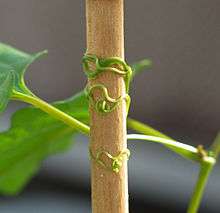Brunnichia
| Brunnichia | |
|---|---|
 | |
| Brunnichia ovata tendrils | |
| Scientific classification | |
| Kingdom: | Plantae |
| (unranked): | Angiosperms |
| (unranked): | Eudicots |
| (unranked): | Core eudicots |
| Order: | Caryophyllales |
| Family: | Polygonaceae |
| Genus: | Brunnichia Banks ex Gaertn. |
| Species | |
|
B. africana | |
The genus Brunnichia, also known as redvine or buckwheat vine, are perennial woody vines native to the United States.
Redvine species are a pest when they grow within crops; for example, B. ovata is a significant problem in soybean crops in the Mississippi Delta.[1] It is an example for thigmotropism. Usually thigmotropism occurs when plants grow around a surface, such as a wall, pot, or trellis. Climbing plants, such as vines, develop tendrils that coil around supporting objects. Touched cells produce auxin and transport it to untouched cells. Some untouched cells will then elongate faster so cell growth bends around the object. Some seedlings also exhibit triple response, caused by pulses of ethylene which cause the stem to thicken and curve to start growing horizontally.
References
- ↑ Reddy, Krishna N.; Chachalis, Demosthenis (2004). "Redvine (Brunnichia ovata) and Trumpetcreeper (Campsis radicans) Management in Glufosinate- and Glyphosate-Resistant Soybean1". Weed Technology. 18 (4): 1058. doi:10.1614/WT-03-234R1.